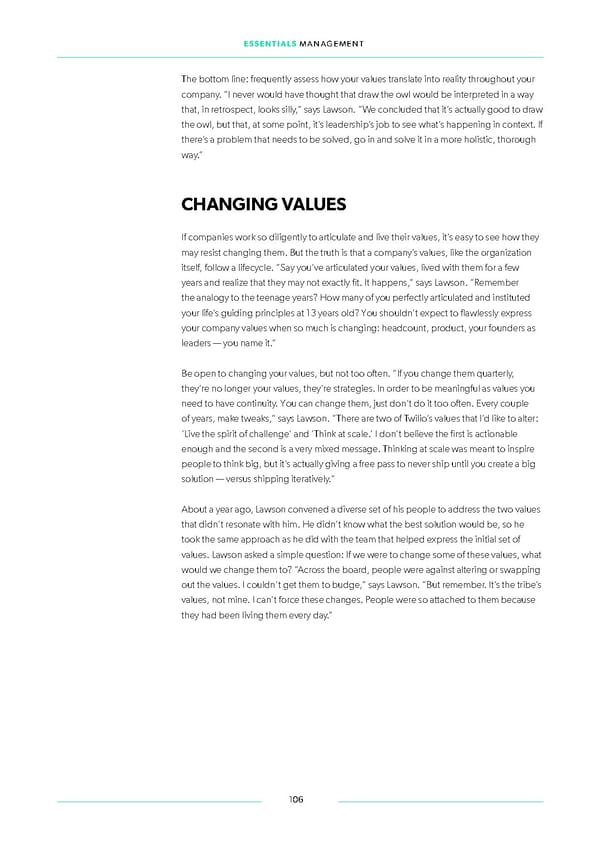ESSENTIALS MANAGEMENT The bottom line: frequently assess how your values translate into reality throughout your company. “I never would have thought that draw the owl would be interpreted in a way that, in retrospect, looks silly,” says Lawson. “We concluded that it’s actually good to draw the owl, but that, at some point, it’s leadership’s job to see what’s happening in context. If there’s a problem that needs to be solved, go in and solve it in a more holistic, thorough way.” CHANGING VALUES If companies work so diligently to articulate and live their values, it’s easy to see how they may resist changing them. But the truth is that a company’s values, like the organization itself, follow a lifecycle. “Say you’ve articulated your values, lived with them for a few years and realize that they may not exactly ift. It happens,” says Lawson. “Remember the analogy to the teenage years? How many of you perfectly articulated and instituted your life’s guiding principles at 13 years old? You shouldn’t expect to lfawlessly express your company values when so much is changing: headcount, product, your founders as leaders — you name it.” Be open to changing your values, but not too otfen. “If you change them quarterly, they’re no longer your values, they’re strategies. In order to be meaningful as values you need to have continuity. You can change them, just don’t do it too otfen. Every couple of years, make tweaks,” says Lawson. “There are two of Twilio’s values that I’d like to alter: ‘Live the spirit of challenge’ and ‘Think at scale.’ I don’t believe the ifrst is actionable enough and the second is a very mixed message. Thinking at scale was meant to inspire people to think big, but it’s actually giving a free pass to never ship until you create a big solution — versus shipping iteratively.” About a year ago, Lawson convened a diverse set of his people to address the two values that didn’t resonate with him. He didn’t know what the best solution would be, so he took the same approach as he did with the team that helped express the initial set of values. Lawson asked a simple question: If we were to change some of these values, what would we change them to? “Across the board, people were against altering or swapping out the values. I couldn’t get them to budge,” says Lawson. “But remember. It’s the tribe’s values, not mine. I can’t force these changes. People were so attached to them because they had been living them every day.” 106
 Essentials Management First Round Capital Page 105 Page 107
Essentials Management First Round Capital Page 105 Page 107